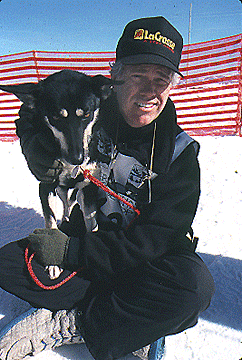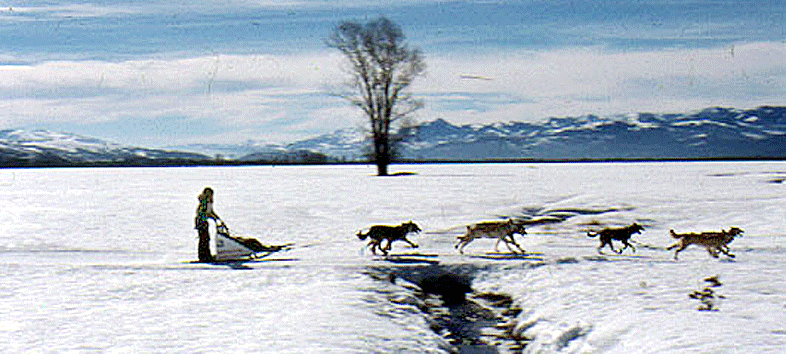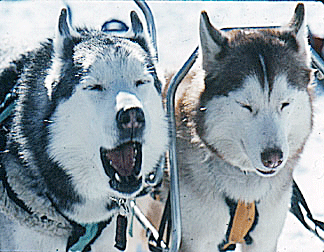|
 With his mittened hand, musher Billy Snodgrass clings to the bucking gee-pole and
holds the sled on the trail. With his other hand he rubs his cheeks and nose to keep them
from freezing. His forehead is covered with the visor of his fur cap, its flaps
covering his ears. The rest of his face is covered by a thick beard, coated with frost. In
front of him churns a heavily loaded sled pulled by a string of eight dogs. He yells
"gee" and the dogs swing to the right. He yells "Whoa" and they come
to a jerking stop. With his mittened hand, musher Billy Snodgrass clings to the bucking gee-pole and
holds the sled on the trail. With his other hand he rubs his cheeks and nose to keep them
from freezing. His forehead is covered with the visor of his fur cap, its flaps
covering his ears. The rest of his face is covered by a thick beard, coated with frost. In
front of him churns a heavily loaded sled pulled by a string of eight dogs. He yells
"gee" and the dogs swing to the right. He yells "Whoa" and they come
to a jerking stop.
Rubbing his nose, he takes off on the frozen surface of a river. Behind him it
stretches away in a mighty curve of many miles, losing itself in the jumble of mountains,
snow-covered and silent. No animals or humming insects break the silence. No birds fly
through the chilled air. There's no sound of man, no disturbance of any kind. All is
still, expect for the shush of the runners and the barking of the dogs.
Jack London describes scenes like this in many of his stories of the Arctic. Nearly
everyone knows of sled dogs and dog mushers because of him. Now would-be mushers who can't
afford to hop aboard the back of a dogsled in Alaska can do so at a destination closer to
home-- in Wyoming.
All of Wyoming's dog sled tours operate out of the Teton-Wind River Mountain area just
south of Yellowstone Park. Trails wind through Shoshone National Forest just east of the
Continental Divide on Togwotee Pass, east of Jackson Hole and west of Dubois. Weather
permitting, tours begin at the end of November and run into April. Wyoming's Wind River
Mountains see fewer crowds and are well suited to expedition dog sledding. Under a
sparkling mantle of snow, the dramatic landscape lends itself to a variety of exciting
runs from forested trails, to frozen flats, to high atop the Continental Divide. This is
winter in the Rockies, winding through an evergreen forest amidst the soaring peeks of
Wyoming, mushing along a snowpacked trail.

 Under the expert guidance of experienced mushers like Iditarod racer Frank Teasley and
veteran racer Billy Snodgrass, novices learn basic techniques, commands and sled control.
Emphasis is placed on the handling, feeding, harnessing and caring for the dogs, essential
elements in gaining good rapport with a team. The dogs, and the special relationship that
visitors develop with them, become the most meaningful part of the experience. Under the expert guidance of experienced mushers like Iditarod racer Frank Teasley and
veteran racer Billy Snodgrass, novices learn basic techniques, commands and sled control.
Emphasis is placed on the handling, feeding, harnessing and caring for the dogs, essential
elements in gaining good rapport with a team. The dogs, and the special relationship that
visitors develop with them, become the most meaningful part of the experience.
These dogs are bred in kennels and begin working in harness at about a year old. Running
in different positions on the team, they quickly learn to work in concert behind the lead
dog. Both Teasley and Snodgrass use Alaskan Husky racing sled dogs. They combine the
strength and speed of the original Eskimo work dogs with the best features of Siberian
Huskies. No other method of method of travel over snow can compare with dog sledding. The
only sounds are the shushing of the runners, the panting of the dogs, and the wind.
< Back to
Travel Articles
Go to next travel article >
|
